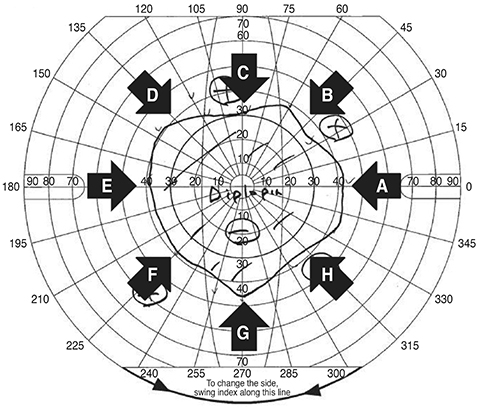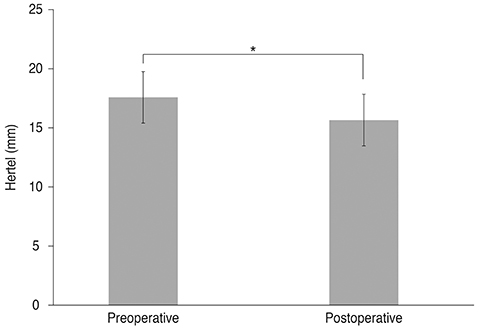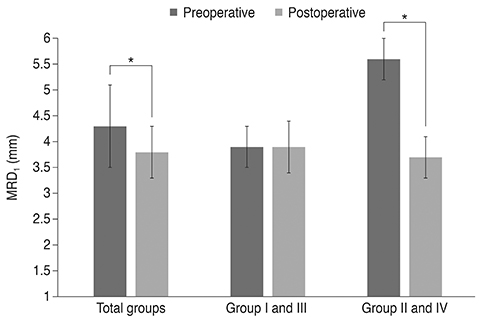Korean J Ophthalmol.
2016 Feb;30(1):1-9. 10.3341/kjo.2016.30.1.1.
Customized Orbital Decompression Surgery Combined with Eyelid Surgery or Strabismus Surgery in Mild to Moderate Thyroid-associated Ophthalmopathy
- Affiliations
-
- 1Department of Ophthalmology, Bundang CHA Medical Center, CHA University, Seongnam, Korea. eye@cha.ac.kr
- KMID: 2363884
- DOI: http://doi.org/10.3341/kjo.2016.30.1.1
Abstract
- PURPOSE
To evaluate the efficacy and safety of customized orbital decompression surgery combined with eyelid surgery or strabismus surgery for mild to moderate thyroid-associated ophthalmopathy (TAO).
METHODS
Twenty-seven consecutive subjects who were treated surgically for proptosis with disfigurement or diplopia after medical therapy from September 2009 to July 2012 were included in the analysis. Customized orbital decompression surgery with correction of eyelid retraction and extraocular movement disorders was simultaneously performed. The patients had a minimum preoperative period of 3 months of stable range of ocular motility and eyelid position. All patients had inactive TAO and were euthyroid at the time of operation. Preoperative and postoperative examinations, including vision, margin reflex distance, Hertel exophthalmometry, ocular motility, visual fields, Goldmann perimetry, and subject assessment of the procedure, were performed in all patients. Data were analyzed using paired t-test (PASW Statistics ver. 18.0).
RESULTS
Forty-nine decompressions were performed on 27 subjects (16 females, 11 males; mean age, 36.6 +/- 11.6 years). Twenty-two patients underwent bilateral operations; five required only unilateral orbital decompression. An average proptosis of 15.6 +/- 2.2 mm (p = 0.00) was achieved, with a mean preoperative Hertel measurement of 17.6 +/- 2.2 mm. Ocular motility was corrected through recession of the extraocular muscle in three cases, and no new-onset diplopia or aggravated diplopia was noted. The binocular single vision field increased in all patients. Eyelid retraction correction surgery was simultaneously performed in the same surgical session in 10 of 49 cases, and strabismus and eyelid retraction surgery were performed in the same surgical session in two cases. Margin reflex distance decreased from a preoperative average of 4.3 +/- 0.8 to 3.8 +/- 0.5 mm postoperatively.
CONCLUSIONS
The customized orbital decompression procedure decreased proptosis and improved diplopia, in a range comparable to those achieved through more stepwise techniques, and had favorable cosmetic results when combined with eyelid surgery or strabismus surgery for mild to moderate TAO.
MeSH Terms
-
Adolescent
Adult
Decompression, Surgical/*methods
Exophthalmos/*surgery
Eye Movements/physiology
Eyelids/*surgery
Female
Graves Ophthalmopathy/*surgery
Humans
Male
Middle Aged
Oculomotor Muscles/surgery
*Ophthalmologic Surgical Procedures
Orbit/*surgery
Retrospective Studies
Strabismus/*surgery
Visual Field Tests
Visual Fields/physiology
Figure
Reference
-
1. McCord CD, Tanenbaum M, Nunery WR, editors. Oculoplastic surgery. 3rd ed. New York: Raven Press;1995. p. 379.2. Kazim M, Goldberg RA, Smith TJ. Insights into the pathogenesis of thyroid-associated orbitopathy: evolving rationale for therapy. Arch Ophthalmol. 2002; 120:380–386.3. Trokel S, Kazim M, Moore S. Orbital fat removal: decompression for Graves orbitopathy. Ophthalmology. 1993; 100:674–682.4. Park JH, Lee TS, Kay KM. Long-term result of fat orbital decompression. J Korean Ophthalmol Soc. 2010; 51:473–478.5. Kamer L, Noser H, Schramm A, et al. Anatomy-based surgical concepts for individualized orbital decompression surgery in graves orbitopathy: I. orbital size and geometry. Ophthal Plast Reconstr Surg. 2010; 26:348–352.6. Siracuse-Lee DE, Kazim M. Orbital decompression: current concepts. Curr Opin Ophthalmol. 2002; 13:310–316.7. Shorr N, Seiff SR. The four stages of surgical rehabilitation of the patient with dysthyroid ophthalmopathy. Ophthalmology. 1986; 93:476–483.8. Goldberg RA, Perry JD, Hortaleza V, Tong JT. Strabismus after balanced medial plus lateral wall versus lateral wall only orbital decompression for dysthyroid orbitopathy. Ophthal Plast Reconstr Surg. 2000; 16:271–277.9. Grenzebach UH, Schnorbus U, Buchner T, et al. Development of ocular motility following modified 3-wall decompression of the orbita in endocrine orbitopathy for functional and rehabilitative indication. Klin Monbl Augenheilkd. 2003; 220:345–351.10. Garrity JA, Saggau DD, Gorman CA, et al. Torsional diplopia after transantral orbital decompression and extraocular muscle surgery associated with Graves' orbitopathy. Am J Ophthalmol. 1992; 113:363–373.11. Nunery WR, Nunery CW, Martin RT, et al. The risk of diplopia following orbital floor and medial wall decompression in subtypes of ophthalmic Graves' disease. Ophthal Plast Reconstr Surg. 1997; 13:153–160.12. Goldberg RA, Kim AJ, Kerivan KM. The lacrimal keyhole, orbital door jamb, and basin of the inferior orbital fissure: three areas of deep bone in the lateral orbit. Arch Ophthalmol. 1998; 116:1618–1624.13. Beden U, Edizer M, Elmali M, et al. Surgical anatomy of the deep lateral orbital wall. Eur J Ophthalmol. 2007; 17:281–286.14. Ben Simon GJ, Syed HM, Lee S, et al. Strabismus after deep lateral wall orbital decompression in thyroid-related orbitopathy patients using automated hess screen. Ophthalmology. 2006; 113:1050–1055.15. Ben Simon GJ, Wang L, McCann JD, Goldberg RA. Primary-gaze diplopia in patients with thyroid-related orbitopathy undergoing deep lateral orbital decompression with intraconal fat debulking: a retrospective analysis of treatment outcome. Thyroid. 2004; 14:379–383.16. Ben Simon GJ, Mansury AM, Schwarcz RM, et al. Simultaneous orbital decompression and correction of upper eyelid retraction versus staged procedures in thyroid-related orbitopathy. Ophthalmology. 2005; 112:923–932.17. Chang HS, Lee D, Taban M, et al. "En-glove" lysis of lower eyelid retractors with AlloDerm and dermis-fat grafts in lower eyelid retraction surgery. Ophthal Plast Reconstr Surg. 2011; 27:137–141.18. Lund VJ, Larkin G, Fells P, Adams G. Orbital decompression for thyroid eye disease: a comparison of external and endoscopic techniques. J Laryngol Otol. 1997; 111:1051–1055.19. White WA, White WL, Shapiro PE, et al. Combined endoscopic medial and inferior orbital decompression with transcutaneous lateral orbital decompression in Graves' orbitopathy. Ophthalmology. 2003; 110:1827–1832.20. Shepard KG, Levin PS, Terris DJ. Balanced orbital decompression for Graves' ophthalmopathy. Laryngoscope. 1998; 108(11 Pt 1):1648–1653.21. Graham SM, Brown CL, Carter KD, et al. Medial and lateral orbital wall surgery for balanced decompression in thyroid eye disease. Laryngoscope. 2003; 113:1206–1209.22. Unal M, Leri F, Konuk O, Hasanreisoglu B. Balanced orbital decompression combined with fat removal in Graves ophthalmopathy: do we really need to remove the third wall? Ophthal Plast Reconstr Surg. 2003; 19:112–118.23. Roncevic R. Correction of exophthalmos and eyelid deformities in patients with severe thyroid ophthalmopathy. J Craniofac Surg. 2008; 19:628–636.24. Baldeschi L, Lupetti A, Vu P, et al. Reactivation of Graves' orbitopathy after rehabilitative orbital decompression. Ophthalmology. 2007; 114:1395–1402.25. Michel O, Oberlander N, Neugebauer P, et al. Follow-up of transnasal orbital decompression in severe Graves' ophthalmopathy. Ophthalmology. 2001; 108:400–404.
- Full Text Links
- Actions
-
Cited
- CITED
-
- Close
- Share
- Similar articles
-
- The Effect of Previous Orbital Decompression on Outcome of Strabismus Surgery in Patients with Thyroid Ophthalmopathy
- Surgical treatment modalities of thyroid ophthalmopathy
- Factors Associated with Postoperative Strabismus by Endoscopic Orbital Decompression in Patients with Thyroid-associated Ophthalmopathy
- Change in Quality of Life after Orbital Decompression Surgery in Patients with Dysthyroid Ophthalmopathy
- Three Wall Orbital Decompression for Compressive Optic Neuropathy in Thyroid Ophthalmopathy






